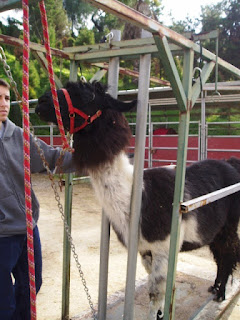| Extroversion | Introversion |
| Sensing | Intuition |
| Thinking | Feeling |
| Judgment | Perception |
Let’s take a look at the pack's personality test results. Which llama do you think and act like? That's your llama-tude!
 |
| Pajama Llama is the most serious in the pack. |
Como T. Llama
Como T. Llama couldn’t be more different than Pajama Llama; in fact, his temperament is the exact opposite! This could explain why the two never hang out. Como is a totally action-oriented extrovert. He wants to play, play and play! But he can’t help it; he’s an ENFP. He acts first and thinks later—or not until Pajama Llama sets him straight with ears back and a stern look. And while Pajama Llama will carefully evaluate a situation, Como relies on his feelings and simply blurts out an alarm call when there really isn't any need to round up the other boys. He's a spontaneous llama who just wants to have fun. Are you a Como T. Llama?
 |
| Bahama Llama is everyone's favorite llama. |
Dalai Llama
Dalai Llama is an ISFP, meaning that he is Introverted, Sensing, Feeling and Perceiving. His introversion dominates his personality. It makes him gentle, sensitive, patient and tolerant. That’s why he prefers to linger at the back of the pack instead of asserting himself. However, because of his beautiful, mystical blue eyes and silky white coat, he appears to be cool and aloof. But he’s really not; he’s quite friendly! In fact, the other llamas invite him to wrestle in almost every match in the arena. Dalai is good at wrestling the other young llamas to the ground, yet he doesn't desire to move up in his pack ranking. He is just happy to be invited to play. Are you a Dalai Llama?
 |
| The opinionated Barack O'Llama |
Barack O’Llama is affectionately called “Barry.” He’s an ESFJ, which makes him the perfect companion for Dalai Llama. And the two really are best buddies! Barry’s extroversion balances Dalai’s introversion, while their common sensing ability makes them both evaluate situations similarly. But Barry is still quite different from Dalai. He often overreacts when his feelings are hurt by another llama encroaching on his personal space. That’s when spit happens, and Barry is the spittiest of the ShangriLlama llamas. But don’t worry; none of them spit at people. Heaven forbid! Only abused or poorly trained llamas do that, and ShangriLlama’s llamas are well trained and quite pampered. Mama Llama thinks that Barry’s spitting may be his way of sharing his opinion about—everything—which is a typical characteristic of an ESFJ, along with talking a lot. Barry, of course, hums rather than talks. Do you happen to be a Barack O’Llama?




























